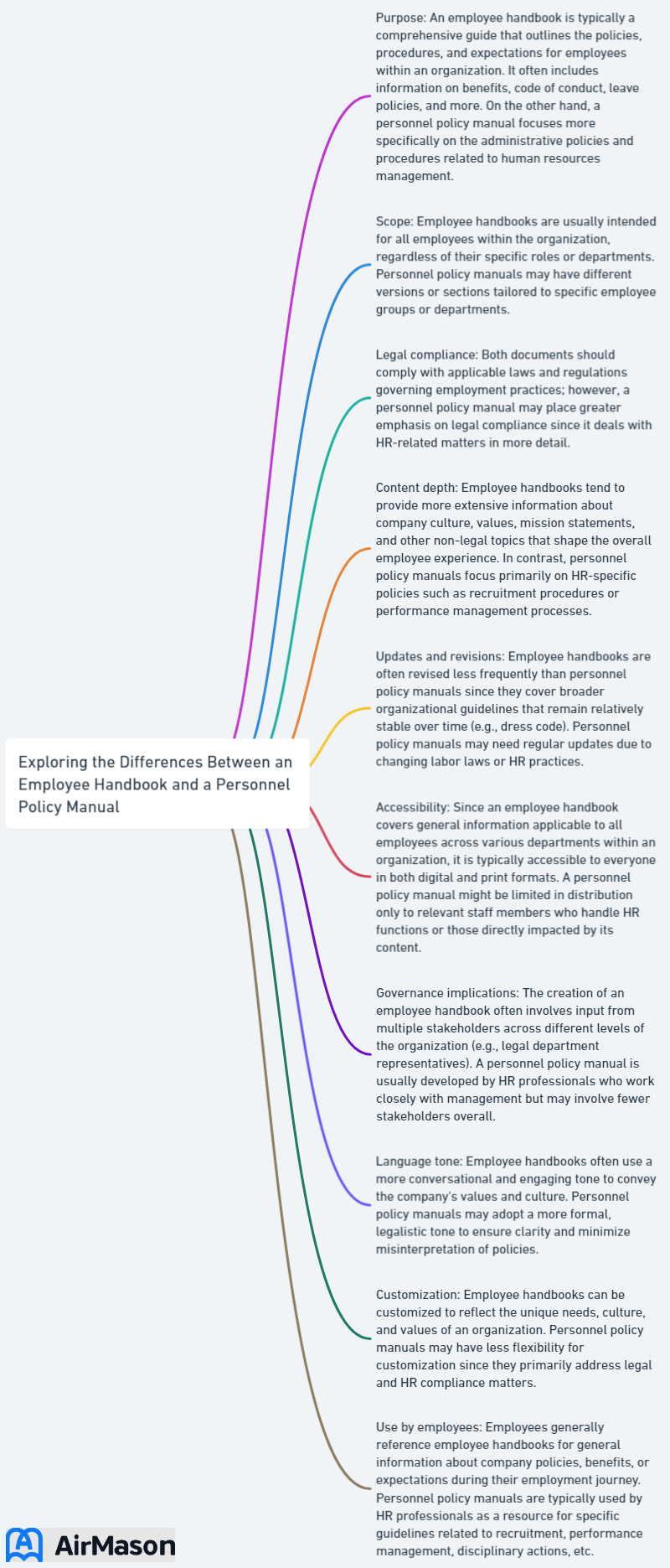
Have you ever wondered about the differences between an employee handbook and a personnel policy manual? These two essential documents serve distinct purposes within an organization, and understanding their differences can significantly impact your company’s efficiency and legal compliance. In this blog post, we will delve into the distinctions between these documents, explore the key components of a personnel policy manual, and provide guidance on crafting an effective policy manual that aligns with your company’s culture and values.
As you read on, you will learn about the role of compliance in a personnel policy manual, the importance of involving stakeholders, and best practices for implementing your policy manual. By the end of this journey, you will have a clear understanding of the crucial elements to consider when developing and maintaining these vital tools for your organization.
Key Takeaways
- A personnel policy manual is a comprehensive guide for HR professionals and company leaders to ensure compliance with applicable employment laws.
- It should incorporate steps, resources, and laws pertaining to employee rights in order to create a systematic approach towards managing workplace situations.
- Crafting an effective Personnel Policy Manual requires considering factors such as company culture, stakeholder involvement, and regular reviews & updates.
Understanding a Personnel Policy Manual
A personnel policy manual is designed to provide comprehensive direction to HR professionals and company leaders regarding intricate scenarios. It comprises standard operating procedures to be adhered to, forms to be utilized, and applicable employment laws that correspond to each policy. A well-crafted policy manual can offer valuable guidance in complicated situations, including employee training.
Compliance with employment law is a fundamental necessity for any organization, with regulations like those enforced by the Equal Employment Opportunity Commission being key to prohibiting discrimination and other policy violations. A solid comprehension of the purpose and audience of a personnel policy manual enables HR teams and managers to navigate more effectively through the complexities of employee conduct and legal requirements.
Key Components of a Personnel Policy Manual

A personnel policy manual should incorporate steps to be taken in specific circumstances, pertinent resources (such as forms, checklists, and templates), and laws pertaining to employee rights. These components are essential in guaranteeing a systematic approach to managing complex situations that may arise in the workplace. Furthermore, by outlining clear expectations, a policy manual contributes to fostering a positive and compliant work environment.
The forthcoming subsections delve into the main elements of a personnel policy manual, concentrating on recruitment and hiring, performance management, and disciplinary procedures. A thorough understanding of these core components will equip you to develop and maintain an all-encompassing, effective policy manual as well as a procedures manual for your organization.
Recruitment and Hiring
Establishing clear policies and procedures for recruitment and hiring, as well as disciplinary action, is of paramount importance to guarantee a methodical and uniform hiring process within an organization. Clear job descriptions, for instance, can be developed by ensuring that they cover all the necessary components accurately, utilizing clear and concise language, and incorporating all relevant details about the role to create a clear understanding.
A well-structured hiring process within a personnel policy manual should include:
- Policy objectives
- Scopes
- Personnel requisitions
- Intake meeting standards
- Overview of the recruitment and selection process, including information on payroll deductions
Adherence to best practices for recruitment and hiring policies allows organizations to effectively navigate the intricate process of attracting and selecting the right talent.
Performance Management
A comprehensive performance management system includes the following components:
- Continuous process designed to enhance performance
- Establishing individual and team objectives in alignment with strategic objectives
- Tracking alignment across the organization
- Defining performance metrics
- Offering feedback and coaching
- Encouraging employee development
- Cooperative system wherein managers and employees collaborate to set expectations and determine goals
The essentials of a performance management system in a personnel policy manual typically comprise measurable and attainable performance elements and standards, goal setting, performance review, performance enhancement, and alignment of organizational goals and objectives with resources accessible. Following advantageous practices for conducting performance reviews, such as articulating the criteria for satisfactory performance and stipulating the frequency and procedures for conducting reviews, can also contribute to a successful performance management system.
Disciplinary Procedures
Having clear disciplinary procedures in place is crucial for maintaining a positive and compliant work environment. Key elements of disciplinary procedures in a Personnel Policy Manual typically include:
- A precise definition of inappropriate behavior or misconduct
- Progressive disciplinary steps
- An investigation process to obtain evidence and facts
- Disciplinary meetings with the employee to discuss the issue
Effectively documenting disciplinary procedures in a Personnel Policy Manual involves:
- Including a clear statement that outlines the right to terminate employees at will
- Informing employees regarding unacceptable behaviors and consequences of violating company policies
- Providing a structured progressive discipline process
A well-defined disciplinary process enables organizations to address employee misconduct, such as substance abuse, more effectively and correct unacceptable behaviors.
CALHR HR Manual
The CALHR HR manual serves as a comprehensive resource and guide for human resources practices within the California state government. This essential document outlines policies, procedures, and best practices related to personnel management, employee relations, recruitment, compensation, and other vital HR functions. The CALHR HR manual plays a fundamental role in ensuring compliance with state laws and regulations, fostering a fair and equitable work environment, and promoting consistent HR practices across various state agencies. It provides essential information for HR professionals and employees alike, offering a clear understanding of their rights, responsibilities, and avenues for addressing HR-related matters. Regular updates and revisions to the CALHR HR manual reflect evolving legislation, industry standards, and organizational needs, making it a dynamic tool in supporting effective HR management within the California state government.
The Role of Compliance in a Personnel Policy Manual

Compliance in a personnel policy manual is of great importance as it guarantees:
- Compliance with employment law
- Lessens the risk of employment liability
- Encourages legal compliance by delineating policies related to safety, ethics, and regulatory requirements
- Assists in establishing definite guidelines and expectations for employees
- Diminishes the possibility of litigation
- Preserves uniformity in the workplace
Ensuring a personnel policy manual’s compliance with the Americans with Disabilities Act of 1990 (ADA) involves following best practices such as:
- Establishing an interactive process
- Educating managers and supervisors
- Developing policies and practices for disability
- Making policies understandable
- Providing contact information
Adhering to a personnel policy manual can offer several advantages, including guaranteeing conformance with employment law and cultivating a positive and compliant work environment.
Crafting an Effective Personnel Policy Manual

In order to create a successful personnel policy manual, it is essential to consider various factors, such as aligning policies with company culture, involving stakeholders, and conducting regular reviews and updates. By taking these factors into account, a comprehensive and effective policy manual can be crafted, which not only addresses the complexities of managing employee conduct but also fosters a positive work environment.
The subsequent subsections delve into these factors in more depth, providing guidance on:
- Aligning policies with company culture
- Involving key stakeholders
- Maintaining the current relevance of your personnel policy manual through regular reviews and updates.
Aligning Policies with Company Culture

Ensuring that your personnel policy manual reflects and supports your company’s culture and values is of utmost importance. A well-crafted policy manual that aligns with the company culture not only contributes to the establishment of a productive work culture but also encourages employee involvement and organizational alignment.
Companies such as Spotify, Netflix, and Atlassian have successfully integrated their personnel policies with their company culture, aligning them with the company’s mission. Recognizing the importance of integrating the personnel policy manual with the company culture, organizations can ascertain that the policies and procedures match the values, objectives, and accepted behavior of the organization, fostering a unified and positive work environment.
Involving Stakeholders

Incorporating stakeholders in the development of a personnel policy manual offers numerous advantages, such as elevated prospects for contribution, augmented stakeholder acceptance, improved communication and cooperation, augmented decision-making, and strengthening long-term relationships. The primary stakeholders in the formulation of a personnel policy manual comprise HR personnel, senior management, legal counsel, and pertinent department heads.
Employee input is essential in formulating an effective personnel policy manual, as it allows for the inclusion of varied perspectives and insights. Including employees in the policy creation process ensures that the policies mirror the workforce’s requirements and concerns, boosting employee engagement and satisfaction while fostering a sense of ownership and investment in the policies. This approach helps to provide employees with a policy manual that truly reflects their needs.
Regular Reviews and Updates

Periodically assessing and revising a personnel policy manual is of great importance to guarantee that the manual accurately reflects current policies and procedures. This helps to diminish the probability of litigation and cultivates a positive work environment by explicitly delineating company policies and expectations.
A personnel policy manual should be evaluated and altered at least yearly to ensure it covers various aspects, including employee expenses and part time employees. Consistent assessments guarantee that the policies remain compatible with any alterations in employment regulations and accurately portray the present requirements of the organization.
Regular reviews and updates of your personnel policy manual safeguard its continued relevance and effectiveness in managing employee conduct and ensuring legal compliance.
Office Procedure Manual
An office procedure manual serves as a comprehensive guide outlining the established protocols and practices within an organization. This crucial document details the standard operating procedures (SOPs) that employees are expected to follow in various aspects of their work. The office procedure manual covers essential information about office etiquette, communication guidelines, workflow processes, document handling, and other pertinent aspects of daily operations. It plays a vital role in ensuring uniformity and efficiency across the organization by providing employees with clear instructions on how to carry out their tasks in a standardized manner. A well-structured and regularly updated office procedure manual contributes to a cohesive work environment and facilitates effective communication, ultimately enhancing productivity and overall operational success.
Employee Handbook vs. Personnel Policy Manual: A Comparison

An employee handbook provides a broad overview of the organization’s policies and culture, while employee handbooks can also serve as a personnel policy manual, which is a more formal and operational document that encompasses procedures to be followed in specific circumstances, applicable resources, and laws pertaining to employee rights. An employee handbook should be accessible, comprehensible, and composed with employees as the primary focus.
Appreciating the differences between an employee handbook and a policy manual ensures that relevant individuals have access to the appropriate level of information, aiding in reducing liability risks in the workplace. Given that each document has its own target audience and unique purpose, it should be straightforward to determine the most suitable option in accordance with your objective.
Implementing Your Personnel Policy Manual
Effectively implementing your personnel policy manual within your organization involves clear communication, adequate training, and ongoing support. Raising employee awareness of the policy manual and its significance, holding staff meetings to communicate policy changes, and providing training sessions to ensure employee understanding of the policies all contribute to a smooth implementation process.
Encouraging two-way communication by inviting feedback and addressing any queries is also vital for successful implementation. Regularly reviewing and updating the policy manual to keep it pertinent and accessible to employees will further contribute to the effectiveness of the implementation process and the overall success of the personnel policy manual within your organization.
Templates for Training Manuals
Templates for training manuals are essential tools in the development of structured and informative training materials. These templates provide a foundational framework that ensures consistency and clarity in conveying important information to trainees. They typically include sections for introductory overviews, specific learning objectives, step-by-step procedures, visual aids, quizzes or assessments, and conclusion summaries. Utilizing such templates streamlines the manual creation process, allowing authors to focus on the content’s quality and relevance rather than formatting concerns. Additionally, these templates assist in aligning the training manual with the overall instructional goals, making them a valuable resource for trainers and educators.
Summary
In conclusion, understanding the differences between an employee handbook and a personnel policy manual is crucial for effectively managing employee conduct and ensuring legal compliance within your organization. By creating a comprehensive and effective personnel policy manual that aligns with your company’s culture, involves stakeholders, and remains current through regular reviews and updates, you can cultivate a positive and compliant work environment.
Remember that the success of your personnel policy manual lies not only in its content but also in its implementation and ongoing support. By effectively communicating the policies, providing training, and encouraging feedback, you will create a valuable tool that contributes to the overall efficiency and legal compliance of your organization.
Frequently Asked Questions
What should be included in a personnel policy?
A personnel policy should include guidelines for hiring, work processes, compensation, leave, training, promotion, work environments, termination, expectations of employees and what employees can expect from the business, reasons for termination, steps before termination, time span, documentation, and people involved.
What is an HR policy manual?
A HR policy manual is a comprehensive guide for management that outlines your organization’s employee-related practices and ensures they are fair and compliant.
What is the difference between employee guide and personnel policy manual?
An employee guide provides general guidance for all employees, whereas personnel policy manuals are more detailed and intended for supervisory staff to effectively implement the organization’s policies.
Why is it important to align the personnel policy manual with company culture?
Aligning the personnel policy manual with company culture helps create a unified and positive work environment by ensuring that policies and procedures reflect the organization’s values, objectives, and accepted behavior.
How can stakeholders be involved in the development of a personnel policy manual?
Stakeholders can provide input and feedback, participate in the policy creation process, and attend staff meetings to ensure personnel policy manuals are developed effectively.